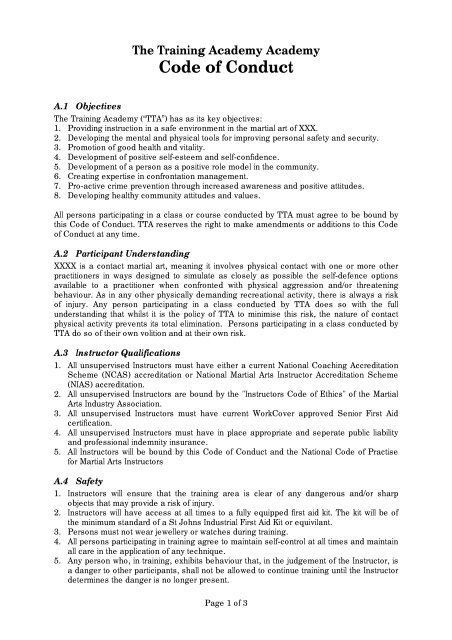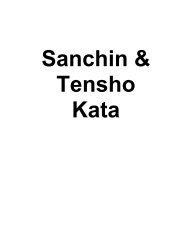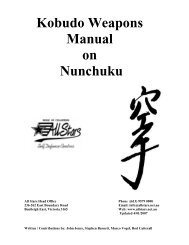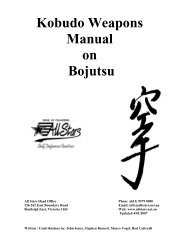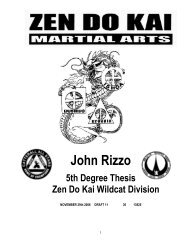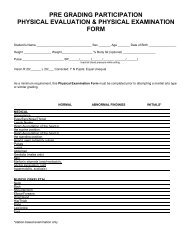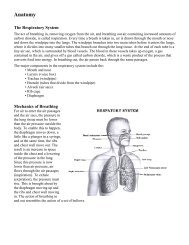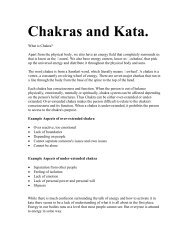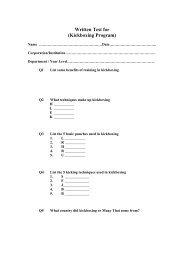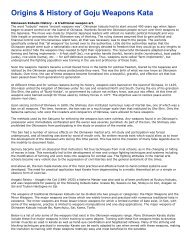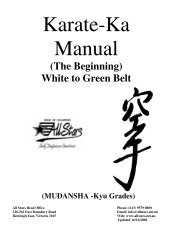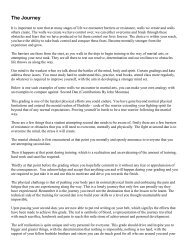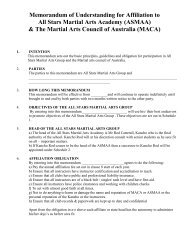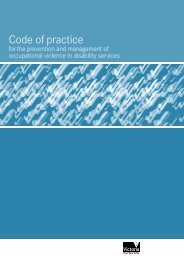Code of Conduct - All Stars Self Defence Centres
Code of Conduct - All Stars Self Defence Centres
Code of Conduct - All Stars Self Defence Centres
- No tags were found...
You also want an ePaper? Increase the reach of your titles
YUMPU automatically turns print PDFs into web optimized ePapers that Google loves.
The Training Academy Academy<strong>Code</strong> <strong>of</strong> <strong>Conduct</strong>A.1 ObjectivesThe Training Academy (“TTA”) has as its key objectives:1. Providing instruction in a safe environment in the martial art <strong>of</strong> XXX.2. Developing the mental and physical tools for improving personal safety and security.3. Promotion <strong>of</strong> good health and vitality.4. Development <strong>of</strong> positive self-esteem and self-confidence.5. Development <strong>of</strong> a person as a positive role model in the community.6. Creating expertise in confrontation management.7. Pro-active crime prevention through increased awareness and positive attitudes.8. Developing healthy community attitudes and values.<strong>All</strong> persons participating in a class or course conducted by TTA must agree to be bound bythis <strong>Code</strong> <strong>of</strong> <strong>Conduct</strong>. TTA reserves the right to make amendments or additions to this <strong>Code</strong><strong>of</strong> <strong>Conduct</strong> at any time.A.2 Participant UnderstandingXXXX is a contact martial art, meaning it involves physical contact with one or more otherpractitioners in ways designed to simulate as closely as possible the self-defence optionsavailable to a practitioner when confronted with physical aggression and/or threateningbehaviour. As in any other physically demanding recreational activity, there is always a risk<strong>of</strong> injury. Any person participating in a class conducted by TTA does so with the fullunderstanding that whilst it is the policy <strong>of</strong> TTA to minimise this risk, the nature <strong>of</strong> contactphysical activity prevents its total elimination. Persons participating in a class conducted byTTA do so <strong>of</strong> their own volition and at their own risk.A.3 Instructor Qualifications1. <strong>All</strong> unsupervised Instructors must have either a current National Coaching AccreditationScheme (NCAS) accreditation or National Martial Arts Instructor Accreditation Scheme(NIAS) accreditation.2. <strong>All</strong> unsupervised Instructors are bound by the "Instructors <strong>Code</strong> <strong>of</strong> Ethics" <strong>of</strong> the MartialArts Industry Association.3. <strong>All</strong> unsupervised Instructors must have current WorkCover approved Senior First Aidcertification.4. <strong>All</strong> unsupervised Instructors must have in place appropriate and seperate public liabilityand pr<strong>of</strong>essional indemnity insurance.5. <strong>All</strong> Instructors will be bound by this <strong>Code</strong> <strong>of</strong> <strong>Conduct</strong> and the National <strong>Code</strong> <strong>of</strong> Practisefor Martial Arts InstructorsA.4 Safety1. Instructors will ensure that the training area is clear <strong>of</strong> any dangerous and/or sharpobjects that may provide a risk <strong>of</strong> injury.2. Instructors will have access at all times to a fully equipped first aid kit. The kit will be <strong>of</strong>the minimum standard <strong>of</strong> a St Johns Industrial First Aid Kit or equivilant.3. Persons must not wear jewellery or watches during training.4. <strong>All</strong> persons participating in training agree to maintain self-control at all times and maintainall care in the application <strong>of</strong> any technique.5. Any person who, in training, exhibits behaviour that, in the judgement <strong>of</strong> the Instructor, isa danger to other participants, shall not be allowed to continue training until the Instructordetermines the danger is no longer present.Page 1 <strong>of</strong> 3
A.5 Training Area Etiquette1. Persons will bow in the appropriate manner upon entering the Training Area.2. Shoes must be taken <strong>of</strong>f before entering the training area unless the shoes are specialmartial arts footwear approved by the Instructor (see “Clothing” below).3. Persons must be punctual, preferably early, so that they are ready to train when classcommences. If arriving late, a person must wait at the side <strong>of</strong> the Training Area until theInstructor indicates that a person may join the class.4. Persons must not chew gum whilst training.5. Food and/or drink (including water) must not be consumed whilst on the training area.6. Mobile phones must be turned <strong>of</strong>f during training. Mobile phones inadvertently left onduring training may not be answered. Any person who is “on-call” for work may seekapproval from the instructor prior to the commencement <strong>of</strong> class to leave his or hermobile phone on.A.6 Uniforms & Training Gear<strong>All</strong> Persons must wear the following approved clothing during all training sessions:1. Pants: Plain black kung fu pants with or without elasticised ankles. Other types <strong>of</strong> longblack pants may be acceptable only if approved by the instructor. During hot weatheronly, long black shorts are permitted. Lycra shorts or tights are not permitted.2. Tops: Plain black t-shirt, singlet or muscle top. Each student must bring two tops to classshould the first top become too wet from perspiration.3. Shoes: Only special martial arts training footwear which has been approved by theinstructor.4. Sashes: Graded students must wear their sash.5. <strong>All</strong> clothing must be free <strong>of</strong> all logos or markings unless the logo is that <strong>of</strong> TTA.6. Persons inappropriately attired will not be allowed to train.7. In addition to the general uniform requirements, persons must bring a towel and filledwater bottle to each training session.A.7 Sparring requirements1. Persons participating in sparring activity must purchase and wear an approved mouthguard and bring this mouth guard to every training session.2. As boxing drills are a regular conditioning activity, persons are encouraged to purchasetheir own set <strong>of</strong> boxing mitts <strong>of</strong> an approved 14oz or 16oz size.3. In addition to their personal mouth guards, persons participating in sparring must wearfull protective clothing, either their own or as supplied by TTA, comprising body guards,head guards, groin guards and 14oz or 16oz boxing mitts.A.8 Sickness or Injury1. Persons must not train if they are suffering from the flu or other viral infection that may bepassed on to other persons.2. Persons must advise the Instructor if suffering from any injury or medical condition, eitherpermanent or temporary, which may be adversely affected by certain types <strong>of</strong> training.Some examples <strong>of</strong> this may include blood pressure problems and cardiac disorders, neckand back injuries, diabetes and asthma.3. If requested by the Instructor, persons with the above or like conditions must show this<strong>Code</strong> <strong>of</strong> <strong>Conduct</strong> to their physician and secure a medical certificate clearly stating thatthe person is able to participate in classes conducted by Australian Shaolin KempoAcademy and whether there are any restrictions or conditions applicable.A.9 Other Health Issues1. Persons must not attend training under the influence <strong>of</strong> alcohol or illegal drugs.2. Smoking is not allowed in the Training Area.Page 2 <strong>of</strong> 3
3. Persons training must give proper attention to personal hygiene and exhibit cleangrooming; and ensure that fingernails and toenails are trimmed and clean..4. Persons with a cut or bleeding injury must cease training immediately and receiveappropriate first aid. Rejoining the training session will not be allowed until the instructorhas deemed that is safe to do so.5. Persons administering first aid to a person suffering a cut or bleeding injury must wearprotective gloves.A.10 Training Area Ethics1. Persons must always be courteous and helpful to each other.2. Physical contact between persons who are training must be appropriate to the situationand necessary for the skill development <strong>of</strong> those persons.3. Sexual harassment, defined as being where a person is subjected to unwanted oruninvited sexual behaviour, will not be tolerated.4. Any form <strong>of</strong> discrimination based on sex, ethnic origin, language, colour, or other form <strong>of</strong>differentiation will not be tolerated.A.11 Grading Conditions1. Opportunity to grade under the TTA syllabus occurs only two times per calendar year. Aperson may only grade at these times subject to the final determination <strong>of</strong> the instructor.2. Each six-month interval between grading is divided into two three-month terms: the Post-Grading Term and the Pre-Grading Term.3. Grading fees must be paid at the commencement <strong>of</strong> the Pre-Grading Term.4. In assessing a person’s readiness to grade, the Instructor takes into consideration suchfactors as consistency <strong>of</strong> attendance, attitude, focus and attention during trainingsessions, as much as a person’s knowledge <strong>of</strong> the TTA syllabus to the point he or shewishes to grade.5. To secure grading under the TTA syllabus a person must be a current financial member<strong>of</strong> TTA.6. Membership <strong>of</strong> TTA requires a person to agree to be bound by this <strong>Code</strong> <strong>of</strong> <strong>Conduct</strong>.7. TTA reserves the right to revoke the grading <strong>of</strong> any person who breaches this <strong>Code</strong> <strong>of</strong><strong>Conduct</strong>.Page 3 <strong>of</strong> 3


